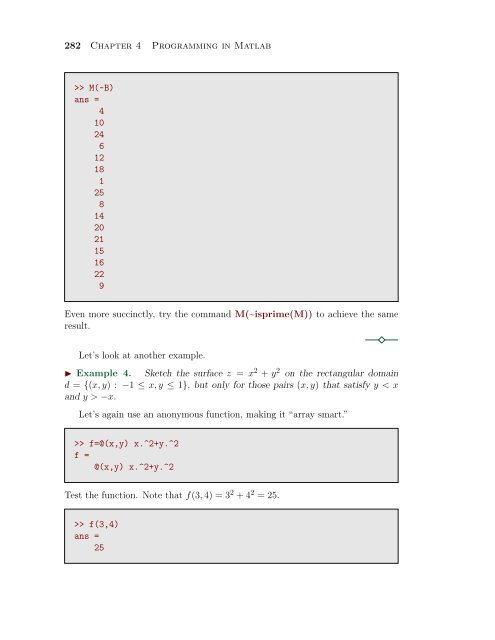- Page 1 and 2: 4 Programming In Matlab In this cha
- Page 3 and 4: Section 4.1 Logical Arrays 261 4.1
- Page 5 and 6: Section 4.1 Logical Arrays 263 >> A
- Page 7 and 8: Section 4.1 Logical Arrays 265 >> u
- Page 9 and 10: Section 4.1 Logical Arrays 267 A nu
- Page 11 and 12: Section 4.1 Logical Arrays 269 Seem
- Page 13 and 14: Section 4.1 Logical Arrays 271 >> k
- Page 15 and 16: Section 4.1 Logical Arrays 273 >> a
- Page 17 and 18: Section 4.1 Logical Arrays 275 >> x
- Page 19 and 20: Section 4.1 Logical Arrays 277 >> m
- Page 21 and 22: Section 4.1 Logical Arrays 279 >> u
- Page 23: Section 4.1 Logical Arrays 281 >> u
- Page 27 and 28: Section 4.1 Logical Arrays 285 4.1
- Page 29 and 30: Section 4.1 Logical Arrays 287 prim
- Page 31 and 32: Section 4.1 Logical Arrays 289 4.1
- Page 33 and 34: Section 4.1 Logical Arrays 291 x=li
- Page 35 and 36: Section 4.1 Logical Arrays 293 29.
- Page 37 and 38: Section 4.1 Logical Arrays 295 Elim
- Page 39 and 40: Section 4.1 Logical Arrays 297 Draw
- Page 41 and 42: Section 4.2 Control Structures in M
- Page 43 and 44: Section 4.2 Control Structures in M
- Page 45 and 46: Section 4.2 Control Structures in M
- Page 47 and 48: Section 4.2 Control Structures in M
- Page 49 and 50: Section 4.2 Control Structures in M
- Page 51 and 52: Section 4.2 Control Structures in M
- Page 53 and 54: Section 4.2 Control Structures in M
- Page 55 and 56: Section 4.2 Control Structures in M
- Page 57 and 58: Section 4.2 Control Structures in M
- Page 59 and 60: Section 4.2 Control Structures in M
- Page 61 and 62: Section 4.2 Control Structures in M
- Page 63 and 64: Section 4.2 Control Structures in M
- Page 65 and 66: Section 4.2 Control Structures in M
- Page 67 and 68: Section 4.2 Control Structures in M
- Page 69 and 70: Section 4.2 Control Structures in M
- Page 71 and 72: Section 4.2 Control Structures in M
- Page 73 and 74: Section 4.2 Control Structures in M
- Page 75 and 76:
Section 4.3 Functions in Matlab 333
- Page 77 and 78:
Section 4.3 Functions in Matlab 335
- Page 79 and 80:
Section 4.3 Functions in Matlab 337
- Page 81 and 82:
Section 4.3 Functions in Matlab 339
- Page 83 and 84:
Section 4.3 Functions in Matlab 341
- Page 85 and 86:
Section 4.3 Functions in Matlab 343
- Page 87 and 88:
Section 4.3 Functions in Matlab 345
- Page 89 and 90:
Section 4.3 Functions in Matlab 347
- Page 91 and 92:
Section 4.3 Functions in Matlab 349
- Page 93 and 94:
Section 4.3 Functions in Matlab 351
- Page 95 and 96:
Section 4.3 Functions in Matlab 353
- Page 97 and 98:
Section 4.3 Functions in Matlab 355
- Page 99 and 100:
Section 4.3 Functions in Matlab 357
- Page 101 and 102:
Section 4.3 Functions in Matlab 359
- Page 103 and 104:
Section 4.4 Variable Scope in Matla
- Page 105 and 106:
Section 4.4 Variable Scope in Matla
- Page 107 and 108:
Section 4.4 Variable Scope in Matla
- Page 109 and 110:
Section 4.4 Variable Scope in Matla
- Page 111 and 112:
Section 4.4 Variable Scope in Matla
- Page 113 and 114:
Section 4.4 Variable Scope in Matla
- Page 115 and 116:
Section 4.4 Variable Scope in Matla
- Page 117 and 118:
Section 4.4 Variable Scope in Matla
- Page 119 and 120:
Section 4.4 Variable Scope in Matla
- Page 121 and 122:
Section 4.5 Subfunctions in Matlab
- Page 123 and 124:
Section 4.5 Subfunctions in Matlab
- Page 125 and 126:
Section 4.5 Subfunctions in Matlab
- Page 127 and 128:
Section 4.5 Subfunctions in Matlab
- Page 129 and 130:
Section 4.5 Subfunctions in Matlab
- Page 131 and 132:
Section 4.5 Subfunctions in Matlab
- Page 133 and 134:
Section 4.5 Subfunctions in Matlab
- Page 135 and 136:
Section 4.5 Subfunctions in Matlab
- Page 137 and 138:
Section 4.5 Subfunctions in Matlab
- Page 139 and 140:
Section 4.5 Subfunctions in Matlab
- Page 141 and 142:
Section 4.6 Nested Functions in Mat
- Page 143 and 144:
Section 4.6 Nested Functions in Mat
- Page 145 and 146:
Section 4.6 Nested Functions in Mat
- Page 147 and 148:
Section 4.6 Nested Functions in Mat
- Page 149 and 150:
Section 4.6 Nested Functions in Mat
- Page 151 and 152:
Section 4.6 Nested Functions in Mat
- Page 153 and 154:
Section 4.6 Nested Functions in Mat
- Page 155 and 156:
Section 4.6 Nested Functions in Mat
- Page 157 and 158:
Section 4.6 Nested Functions in Mat
- Page 159 and 160:
Section 4.6 Nested Functions in Mat
- Page 161 and 162:
Section 4.6 Nested Functions in Mat
- Page 163 and 164:
Section 4.6 Nested Functions in Mat
- Page 165 and 166:
Section 4.6 Nested Functions in Mat
- Page 167 and 168:
Section 4.6 Nested Functions in Mat
- Page 169 and 170:
Section 4.6 Nested Functions in Mat
- Page 171 and 172:
Section 4.6 Nested Functions in Mat

















